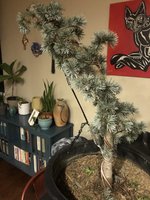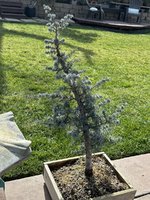You are using an out of date browser. It may not display this or other websites correctly.
You should upgrade or use an alternative browser.
You should upgrade or use an alternative browser.
Blue atlas cedar bending
- Thread starter Hbhaska
- Start date
62veedub
Yamadori
I’ve never grown one as bonsai, but I did plant one in my yard. Beautiful trees! Yours seems like it has a straight even trunk. Are you planning on curves or just one gentle curve?
May I suggest another method?
Get a piece of rebar. Tie it to the base of the tree with strong wire, using rubber padding to protect the bark wherever metal would touch the tree. Use a block of wood as a spacer between the rebar and the trunk of the tree. Again, pad with rubber. Use more wire and rubber above the block of wood to apply pressure and make the bend. In this way, you can create a much sharper curve.
Get a piece of rebar. Tie it to the base of the tree with strong wire, using rubber padding to protect the bark wherever metal would touch the tree. Use a block of wood as a spacer between the rebar and the trunk of the tree. Again, pad with rubber. Use more wire and rubber above the block of wood to apply pressure and make the bend. In this way, you can create a much sharper curve.
Hbhaska
Chumono
Thank you, Adair. This sounds interesting and I would like to try. I’m having a little trouble visualizing the wood spacer. Would you happen to have a picture?May I suggest another method?
Get a piece of rebar. Tie it to the base of the tree with strong wire, using rubber padding to protect the bark wherever metal would touch the tree. Use a block of wood as a spacer between the rebar and the trunk of the tree. Again, pad with rubber. Use more wire and rubber above the block of wood to apply pressure and make the bend. In this way, you can create a much sharper curve.
Hbhaska
Chumono
Thanks. Just one for this season.I’ve never grown one as bonsai, but I did plant one in my yard. Beautiful trees! Yours seems like it has a straight even trunk. Are you planning on curves or just one gentle curve?
KiwiPlantGuy
Omono
Thank you, Adair. This sounds interesting and I would like to try. I’m having a little trouble visualizing the wood spacer. Would you happen to have a picture?
I think what @AdairM is saying that the size of the block could be any length depending on how much trunk bend you want. The longer the piece of wood the more curve and you don’t need to worry about breaking this as Cedars are flexible. You may have to take this in stages.
He can correct me if I am off track.
Nice tree with loads of options.
Charles
I think what @AdairM is saying that the size of the block could be any length depending on how much trunk bend you want. The longer the piece of wood the more curve and you don’t need to worry about breaking this as Cedars are flexible. You may have to take this in stages.
He can correct me if I am off track.
Nice tree with loads of options.
Charles
Yamabudoudanshi
Shohin
I guy I follow on instagram does some pretty extreme work (mostly on white pines) and often uses rebar/wood blocks.
https://www.instagram.com/yoshio.nihei/?hl=en
Check out his pictures to see what Adair is talking about.
https://www.instagram.com/yoshio.nihei/?hl=en
Check out his pictures to see what Adair is talking about.
Brian Van Fleet
Pretty Fly for a Bonsai Guy
I can’t find a picture right now.Thank you, Adair. This sounds interesting and I would like to try. I’m having a little trouble visualizing the wood spacer. Would you happen to have a picture?
Start by placing the rebar next to the trunk at the base of the tree. Put some rubber (I would use some rubber salvaged from an old water hose) to protect the bark. Wire the rebar so that it is secure, next to the base of the trunk.
The trunk is straight, and the rebar is straight, right? They’re parallel? Ok, now grab the trunk, and pull it away from the rebar. The rebar stays being straight, the trunk curves away. Wedge a block of word in between the rebar and the trunk. The larger the block of wood, and the farther down you wedge it, the more the trunk is forced to bend.
At this point, you’ve forced the trunk to move away from the bar of rebar. The wood is separating them. The whole thing looks like a V.
Now, pull the trunk back towards the rebar. The block of wood keeps the trunk away from the rebar, as you pull the top of the tree back.
Pull so that the trunk comes back to touch the rebar. It should look roughly like a D, where the straight vertical line of the D is the rebar, and the curved part is the trunk.
You can manipulate how fat the D is by adjusting the position and size of the block of wood. Also, by adjusting at what point you reunite the trunk and rebar up higher. The higher to tie them back together, the less severe the bend. If you want a severe bend, make the junction of rebar and trunk closer to the block of wood. The trunk and rebar would cross at that point. Tie them together with wire, being careful to pad with rubber.
Hbhaska
Chumono
thank you, @Adair M for the nice explanation and @Brian Van Fleet for the visual. Now I know exactly how this works.
Hbhaska
Chumono
Agree, there are some pretty impressive styling pictures on that Instagram. ThanksI guy I follow on instagram does some pretty extreme work (mostly on white pines) and often uses rebar/wood blocks.
https://www.instagram.com/yoshio.nihei/?hl=en
Check out his pictures to see what Adair is talking about.
VAFisher
Masterpiece
Personally, on this particular tree, I would consider leaving the trunk straight and going for a formal upright with the branches bent sharply down. My $.02 for what that's worth.






